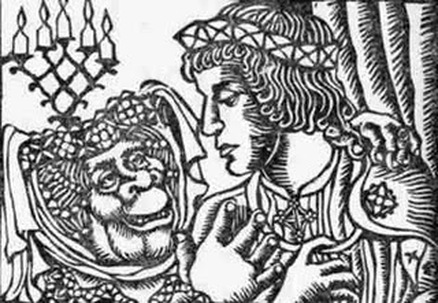Ugliness-definition through contrast. In order for the authors to explain this concept they had to define what beauty was at the time.
"Female hair had to be long and blonde; foreheads had to be smooth and moderate-sized; eyebrows had to be delicate; a chest had to be white; breasts had to be firm and little, and the like" (Curry 3).
"Whiteness was the unquestionable norm. Apart from such idealizations, it was also customary to emphasize women's beauty with comparisons to beautiful things such as lilies, the rising sun, the nightly sky, or red roses" (Evans 233).
The authors state that ugliness was the exact opposite of these features and that is how Medieval poetry perceived women who were ugly. They would be explained as the opposite of these features.
This next one is my favorite! Ugliness- stigma of inadequacy. This is another way that authors portrayed women and their ugliness by showing their lack in certain feminine fields.
"When it came to women, descriptions of beauty accorded with the medieval demand that a respectable damsel had to act as the "desirable object of conquest and love" and motherhood (Kasten 256), while highlighting her ugliness was to reveal her assumed shortcomings in these fields."
So basically women who were seen as beautiful in these texts were damsels in distress that needed a strong man to swoop in and save them and if a women didn't have those qualities she was seen as ugly. How about instead of seeing her as ugly she should be seen as a powerful woman who could do just fine on her own without needing a man to rescue her!
My question to all of you is where have we seen this portrayal in the texts that we have read this semester? Were the women portrayed in the same light as the damsel in distress or were they portrayed in a different way?
I found this article to be very interesting and it is worth taking a look at especially if your final paper will be about the portrayal of women in the texts that we have read this semester.
, 2015, The Concept of Feminine Ugliness in Medieval English Poetry, München, GRIN Verlag, http://www.grin.com/de/e-book/305985/the-concept-of-feminine-ugliness-in-medieval-english-poetr
http://www.grin.com/de/e-book/305985/the-concept-of-feminine-ugliness-in-medieval-english-poetry

This is a depiction of Dame Ragnelle!

This is the typical depiction of what it mean to be a "beautiful women". We can see that she clearly has long hair, she is pale, and she is able to attract a man.

Firm breasts, blonde hair, delicate eyebrows, seems like not much has changed in Western beauty standards over the ages.
ReplyDeleteAlso it reminds me of the discussion I've seen over how lesbian relationships are accepted so long as both women are attractive to men. Really there are a lot of toxic ideas addressed in this post that have yet to be truly worn away.
It's why I admire women such as Frieda Kahlo, who revel in defying beauty standards.